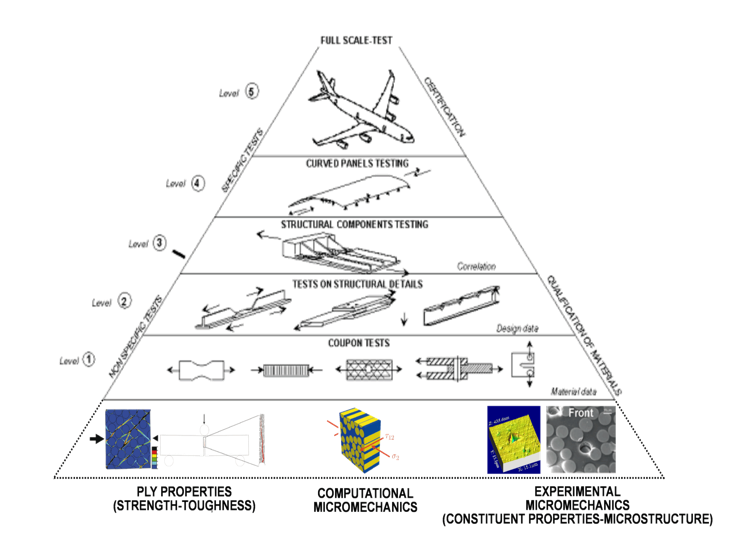![]()
DYNACOMP. Training the next generation of composite engineers in the era of virtual testing.
The use of polymer based composite materials in aircraft structures has increased dramatically in the last decades and today they represent up to 50% in weight (Airbus A350 and Boeing B787 Dreamliner aircrafts) for wings, fuselage sections and tail surfaces. The driving force for the introduction of these materials in transport has been their contribution to weight reduction and fuel consumption savings, while offering outstanding mechanical properties. However, the use of composite materials in other parts of the planes that could benefit from the low weight, such as the fan blades of engines and/or nacelles, is progressing more slowly. This is partly because, even though some composite materials have shown a good response against strike incidents (bird or ice impact), experts do not yet fully understand why.
Understanding this dynamic behaviour is key for the incorporation of advanced composites in engines such as the Rolls Royce UltraFan™ concept. This engine “could be ready for service from 2025 and will offer at least 25 per cent improvement in fuel burn and emissions against the same baseline[1]”. This dramatic increase in performance is expected to be achieved, amongst others, by the replacement of traditional metallic alloys by means of lighter composites. Carbon-titanium blades are one example of the novel components this engine will make use of.
 The DYNACOM European Industrial Doctorate, a research endeavor funded by the Marie Skłodowska-Curie actions, aims at achieving the necessary knowledge on the dynamic behavior of composite materials, while contributing to building a new design paradigm in composite materials. The new design paradigm will accelerate the introduction of new composite materials in aeronautical parts that require a good dynamic behavior, such as the fan blades of the engine. As a matter of fact, the traditional trial and error approach currently used in the design of new aeronautical structural parts, requires a vast and expensive experimental testing campaign at coupon, component and (finally) structure level (see the figure below). DYNACOMP aims at reducing the cost and time-to-market associated to this pyramidal testing campaign by adding a bottom level (see the figure below), based on a virtual testing strategy, following a multiscale simulation approach and supported by a reduced and cheap set of mechanical tests at the micro-scale.
The DYNACOM European Industrial Doctorate, a research endeavor funded by the Marie Skłodowska-Curie actions, aims at achieving the necessary knowledge on the dynamic behavior of composite materials, while contributing to building a new design paradigm in composite materials. The new design paradigm will accelerate the introduction of new composite materials in aeronautical parts that require a good dynamic behavior, such as the fan blades of the engine. As a matter of fact, the traditional trial and error approach currently used in the design of new aeronautical structural parts, requires a vast and expensive experimental testing campaign at coupon, component and (finally) structure level (see the figure below). DYNACOMP aims at reducing the cost and time-to-market associated to this pyramidal testing campaign by adding a bottom level (see the figure below), based on a virtual testing strategy, following a multiscale simulation approach and supported by a reduced and cheap set of mechanical tests at the micro-scale.
In order to achieve this ambitious goal, the DYNACOMP network will offer two Early Stage Researchers (ESRs) a comprehensive training programme with the objective of establishing the new design paradigm introduced in the previous paragraph. Andrea Trevisi and Maria Azzurra, Master’s degree in Materials Engineering by the University of Salento in Italy, are the two ESRs selected to carry out this project (starting in January 2017). Their work will be closely guided and supervised by renewed scientist in multiple disciplines: IMDEA Materials Institute (experts in micro-mechanics and modelling, leading the scientific direction of the project), HEXCEL (a global producer of advanced composites, end user) and Micro Materials (manufacturer of nanomechanical instruments). The quality of the training programme the ESRs will receive along the project will be monitored by Madri+d foundation and by the Technical University of Madrid.
The long-term goal of the DYNACOM project is to stablish a Doctorate programme on the dynamic behaviour of composite materials so that the next generation of composite engineers in the era of virtual testing are incorporated into the labour market.
Test pyramid currently used in aeronautics for the introduction of new materials in structural components. The bottom level represents the novel design paradigm proposed by the DYNACOMP project.


Veja mais em: http://magraprasempre.com/receitas-saudaveis-faceis-para-emagrecer/
wow